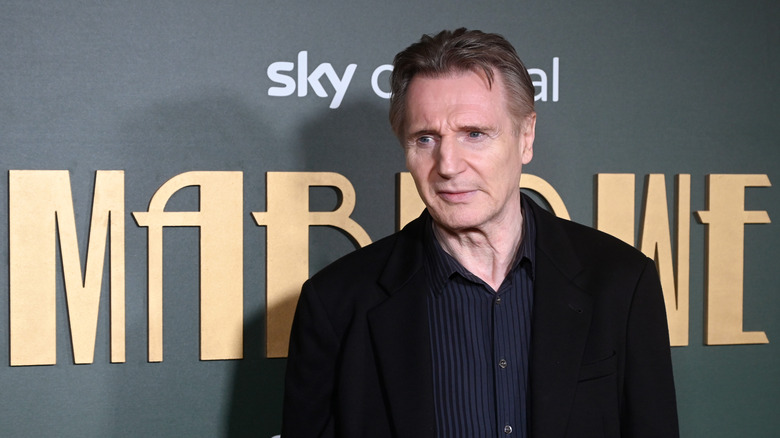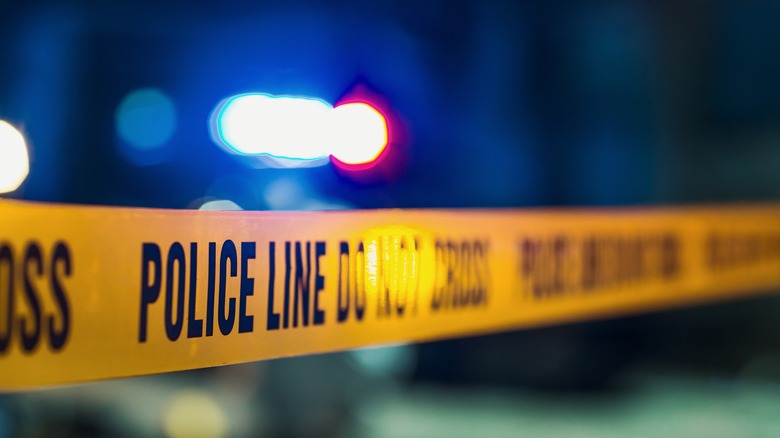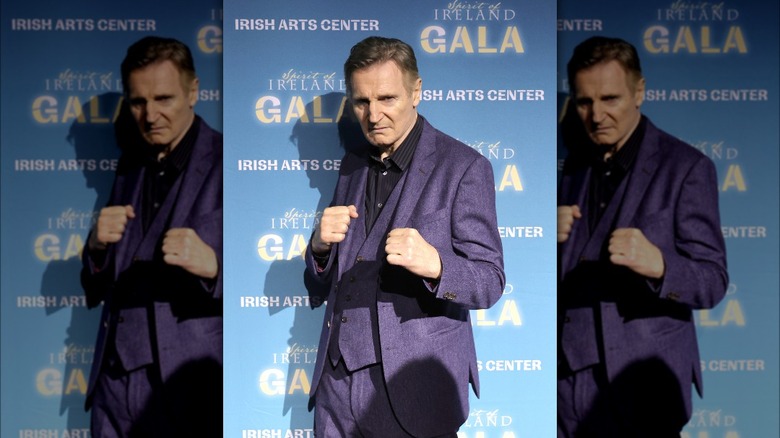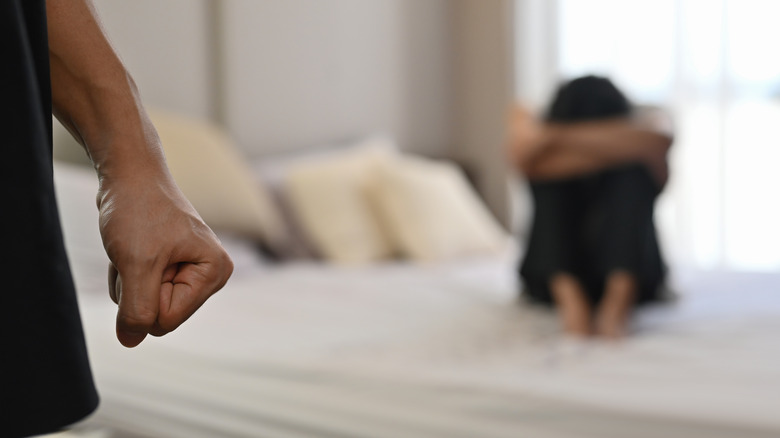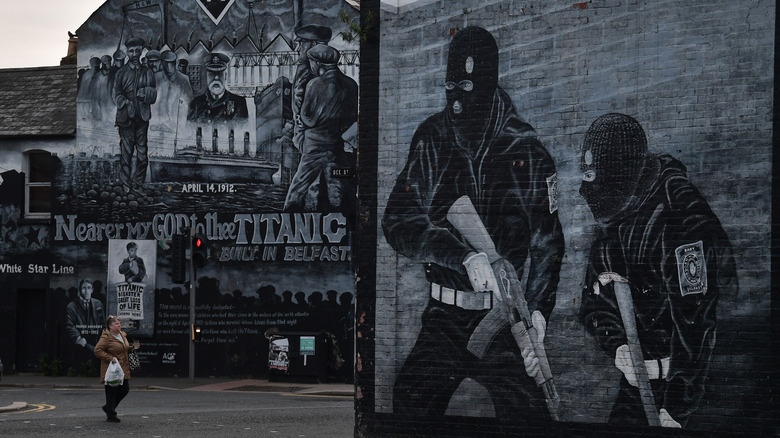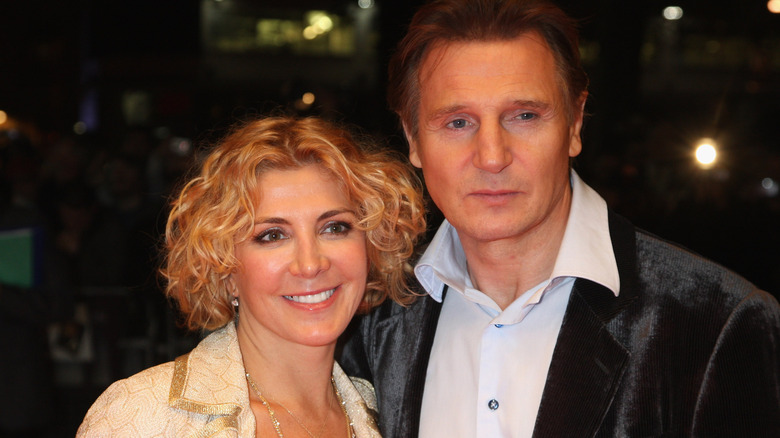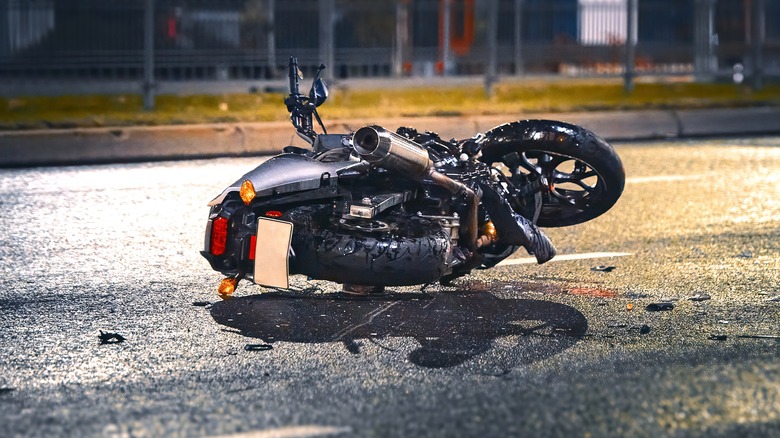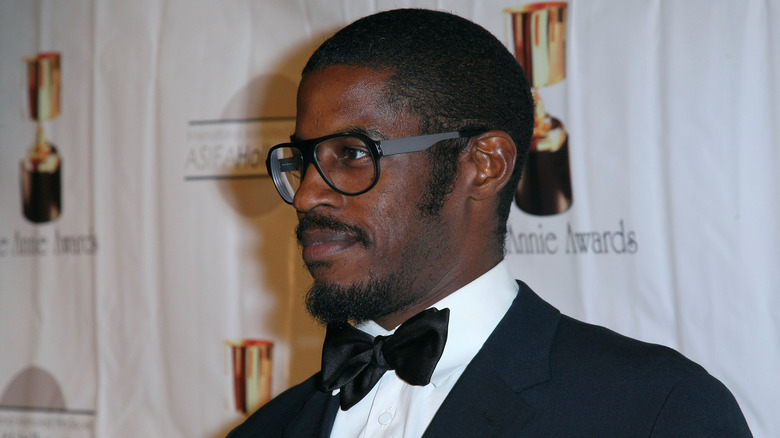The Tragic Real-Life Story Of Liam Neeson
Liam Neeson is legendary not just for his acting, but also for his measured and nuanced opinions on a variety of issues, both inside and outside the acting world. When one listens to him speak, one cannot help but think the wise Jedi master Qui-Gon Jinn, whom Neeson played in Star Wars Episode I, has come to life. Given the tragedies he has faced and the lessons he has learned, this should come as no shock. Growing up in the strife-torn Northern Ireland of the 1960s and 70s, Neeson witnessed the brutality and loss that sectarianism, blind hate, and revenge can inflict – it hit close to home when he lost acquaintances to terrorism and The Troubles. Since then, Neeson's life has been marked with a small number of intense personal tragedies, giving him a grey eminence that continues to inspire today. Here is the tragic facet of his life story.
The following article includes allegations and descriptions of sexual assault, domestic abuse, and addiction.
His close friend was raped
In a 2019 interview with The Independent, Liam Neeson recounted that a woman he knew (their relationship is unclear) was raped by a Black assailant when he was growing up in Northern Ireland. While the victim was able to contend with the traumatic incident, Neeson decided he wanted to take revenge – if not on her assailant, then on those who looked like him. "There's something primal – God forbid you've ever had a member of your family hurt under criminal conditions," he told the outlet.
Neeson said he spent approximately two weeks wandering the streets at night, hoping a black man would try picking a fight with him so he could beat him up or even kill him in revenge. The victim, who appears to have been quite close to him, would inquire about these late-night misadventures, as Neeson described, "'Where are you going?' [she asked] and I would say, 'I'm just going out for a walk.' You know? 'What's wrong?' 'No no, nothing's wrong.'"
Neeson said he eventually realized that although his reaction was normal and understandable from a psychological perspective, it was not productive and morally very, very wrong. Attacking an innocent person was not going to undo the victim's trauma, nor was it going to improve her situation – a lesson he learned not just from that particular experience, but also from watching the cycle of killings and counter-killings between Catholics and Protestants in Northern Ireland. After the interview, the actor was roundly criticized as a racist, while The Queen's University in Belfast even airbrushed him out of their brochure.
Concussion ended his boxing career
Liam Neeson took up boxing at age 9, when his parish priest started a club. He was pretty good, too, winning the Northern Ireland junior championship three times and runner-up on several other occasions. His hero was Muhammad Ali, who sidelined a Broadway acting career to focus on boxing, the opposite of Neeson's path. The 1968 Mexico City Olympic Games looked like a real possibility – at least to the big-dreaming 12-year-old.
Five years later, Neeson chose to hang up his gloves. He told ESPN, "... I came out of the ring and I had obviously got a concussion because my trainer said to go downstairs and take my clothes off and stuff, and I couldn't figure out what downstairs meant ... It lasted for about three minutes or so. I remember thinking, I've got to get out of this. It's not comfortable anymore."
In the end, Neeson said that although it hurt to leave something he had dedicated his teen years to, it was probably for the best. In an interview with the Huffington Post, he said he was not cut out for the pros and lacked time to train to that level. "I certainly felt that I needed to be training five or six nights a week and I just couldn't put that time in. And I thought, 'If I can't put the time in, that's when you get hurt," he told the outlet. Instead, he became involved in drama and eventually ended up a world-class actor.
He regularly witnessed domestic assault
Liam Neeson has often played roles in action movies with their fair share of violence, something he attributes in part to his upbringing in the violence-scarred Northern Ireland of the 60s and 70s. There, he not only witnessed the Catholic-Protestant conflict, but also domestic violence that was literally next door.
While Neeson grew up in a good home, his next-door neighbor's home was broken. In an interview with AARP, he revealed, "... when I was growing up, we had a neighbor next door — we lived in these little terrace houses — and I remember hearing her being beat up by her drunken husband every weekend." He said that although the involved parties were now dead, the repeated incidents scarred him to the point he never really got over them. Despite hearing something so obviously wrong so close by – a man beating the woman he had promised to love, honor, and protect – he could do nothing about it.
Neeson added that the experience influenced his acting career, noting that he liked violent roles because they allowed him to try and "bring some quality of redemption or justice." This idea agrees with Neeson's other experiences, such as when he wandered the streets looking to avenge the rape of a friend.
He reportedly lost acquaintances during The Troubles
Liam Neeson grew up in Northern Ireland in the 60s and 70s, during the Catholic-Protestant conflict known as "The Troubles." The unrest saw riots, killings and counter-killings, bombings, and the infamous "Bloody Sunday" massacre, in which British paratroopers killed 13 protestors opposed to internment of suspected nationalists — and inspired the U2 song "Sunday Bloody Sunday." In response to British policies, Northern Irish Republicans, who supported ending the division of Ireland by uniting with the Republic of Ireland, went on a hunger strike in 1981. They included several men sentenced to prison on terrorism charges.
In an interview with The Independent, Neeson said that he personally knew a handful of the 10 men who died in the hunger strike. While he did not elaborate on his relationship with them – or the other acquaintances who he said "were very caught up in the Troubles" – he implied that their deaths were tragic and perhaps avoidable. He added that they had died from wanting to seek revenge against their enemies, something that was ultimately counterproductive and only fueled the cycle of violence.
Reportedly, it was unclear exactly which of the hunger strikers Neeson knew. Local politicians did not respond with any official comments, and Neeson himself never actually identified them. It is suspected, however, that if he knew any of them, they would have been Francis Hughes and Thomas McElwee, who were from a town 15 minutes away from where Neeson grew up.
He had to pull the plug on his wife in 2009
Liam Neeson and his late wife Natasha Richardson met under sketchy circumstances, falling in love when Richardson was still married to Robert Fox. Nevertheless, after Richardson's divorce, they married – on the condition Neeson turned down any part in the James Bond movies. The two had a healthy marriage until tragedy struck in 2009.
While skiing in Canada, Richardson took a tumble and hit her head against the ground. Initially, it seemed to be nothing: She refused all aid from first responders, and was fine for the next few hours. However, she soon complained of head pain and eventually had to be taken to hospital. She had suffered an epidural hematoma, a head injury in which blood builds up between the outer membrane of the brain and the skull.
Neeson told Anderson Cooper on 60 Minutes about the heart-wrenching decision to end his wife's life. "Sweetie, you're not coming back from this. You've banged your head. It's– I don't know if you can hear me, but that's– this is what's gone down," he recounted. "She and I had made a pact. If any of us got into a vegetative state, we'd pull the plug." Neeson did exactly that, allowing his wife to die with dignity after allowing family members to say their goodbyes, rather than leaving her to suffer in a braindead state. Neeson never quite fully recovered from Richardson's tragic death, claiming he still talks to her as if she were alive.
He broke his pelvis in a motorcycle accident
In 2000, Liam Neeson suffered a near-fatal motorcycle crash on a country road in Duchess County, New York, when he collided with a deer. He was thrown into an embankment, but was fortunately wearing a helmet, which likely saved him from fatal cranial injuries. He crawled back to the road, where a truck driver noticed him and called an ambulance. Although he personally did not expect to survive, he escaped with just a broken pelvis and some leg injuries.
Although Neeson recovered from the accident with no permanent damage, the accident influenced his marriage with his wife, Natasha Richardson, and his career path. "I've read a couple of scripts where the character's on a motorbike, and I'm like, 'Is this important to the script?' 'Yeah, it is.' 'OK, I'm not in,'" he told Men's Journal in 2018. He added that this was not solely his choice – his wife played a role, too. When the Men's Journal interviewer told him about a bike accident he had suffered, Neeson told him such incidents were not fun and games. He implied that had he died in the accident, he would have left his wife and children alone. Thus, he urged the interviewer to "Make a pact with [his] wife. And don't cheat on it," implying Natasha urged him to give up motorbikes – something that cannot have been easy for Neeson considering his love of tough-guy action hero roles.
His fellow actor and friend nearly killed himself over fan hate
It hurts to see a close friend suffer, let alone consider death by suicide. Liam Neeson experienced it firsthand when co-actor Ahmed Best, like so many other actors, nearly had his life destroyed by Star Wars' fanatical fans over his role as Jar-Jar Binks in Star Wars Episode I: The Phantom Menace. Fans panned Best's performance (and the movie in general), even leaking Best's address and phone number so people could send him unhinged hate mail. "I had death threats through the internet," Best told Wired. "I had people come to me and say, 'You destroyed my childhood." Best was not used to the hate – Star Wars was the then-25-year-old actor's first major role. Unable to handle the hate, even before the era of social media, Best nearly died by suicide.
Neeson, who played Jedi master Qui-Gon Jinn, said that it cut him to the core to see Best – a guy whom he referred to as one of the funniest actors he had ever known – treated that way. He told Empire Online that "[he] and Ewan [McGregor] were personally hurt and offended by the critical reaction to the character." Fortunately, Best recovered and went on to a successful movie career. Neeson has since parted ways from the Star Wars franchise over fan behavior, referring to it as a cult that turns even grown men into children with its constant stream of cheap spinoffs.
He struggled with substance abuse issues
Between his motorcycle accident in 2000 and his wife Natasha Richardson's tragic death in 2009, Liam Neeson had drowned out a share of pain and sorrow with alcohol and other intoxicants. In an interview with GQ, Neeson said he nearly became addicted to opiates, which count among the most historically dangerous drugs due to their easy accessibility through prescription. "They took me to the hospital and gave me morphine ... when they give you that drip that you give yourself every six minutes ... I knew I was hooked, because I was counting those [f******] drips, the seconds until I could push that button, and it was instantaneous, that high was," he told the outlet. Neeson said the experience led him to oppose legalization of recreational drug use, noting that even a one-time experimentation can result in addiction that destroys a person's life and those of his loved ones.
Once his wife died, Neeson found himself turning to alcohol for comfort, although, unlike some actors who got drunk during filming, he only did so in the evening. "It was like, so easy to just ... Never at work, never would do it like that, but this time of night? Sitting with you, I'd easily have ..." He noted that he was regularly drinking several bottles of Guinness beer a day (any more than two drinks daily is considered a health risk). In the end, he opted to mostly give up drinking, although it seems he still occasionally enjoys low-alcohol Pinot Noir wine.
If you or anyone you know may be the victim of sexual assault or domestic abuse, or needs help with addiction issues, or is struggling or in a crisis, contact the relevant resources below:
-
The Rape, Abuse & Incest National Network website or contact RAINN's National Helpline at 1-800-656-HOPE (4673).
-
The National Domestic Violence Hotline at 1−800−799−7233. You can also find more information, resources, and support at their website.
-
The Substance Abuse and Mental Health Services Administration website or contact SAMHSA's National Helpline at 1-800-662-HELP (4357).
-
Call or text 988 or chat 988lifeline.org
